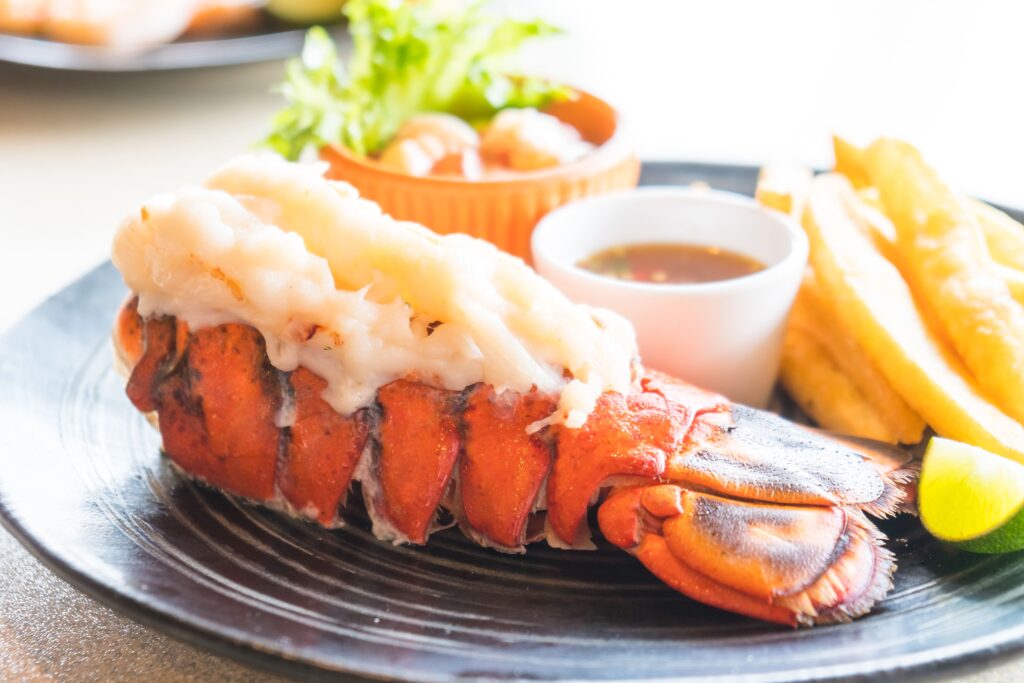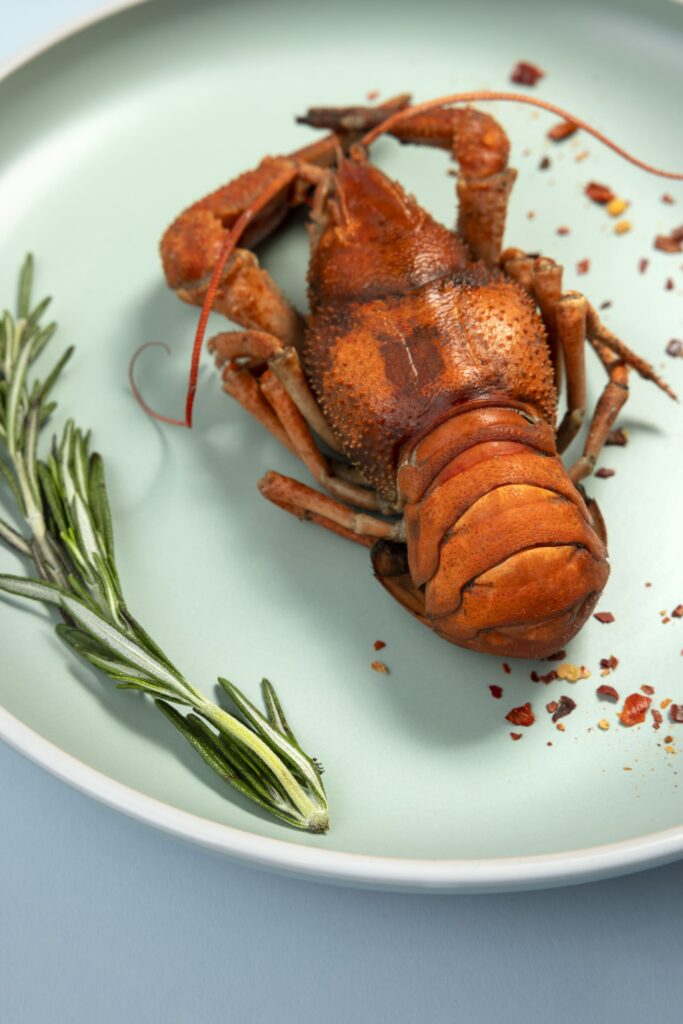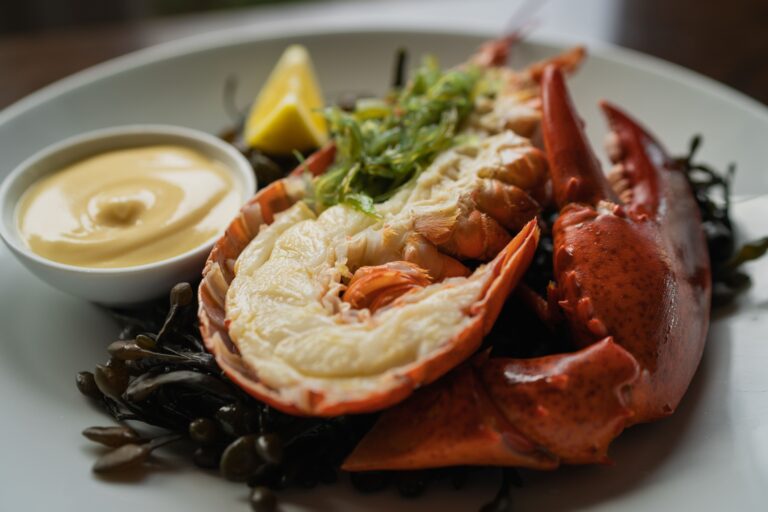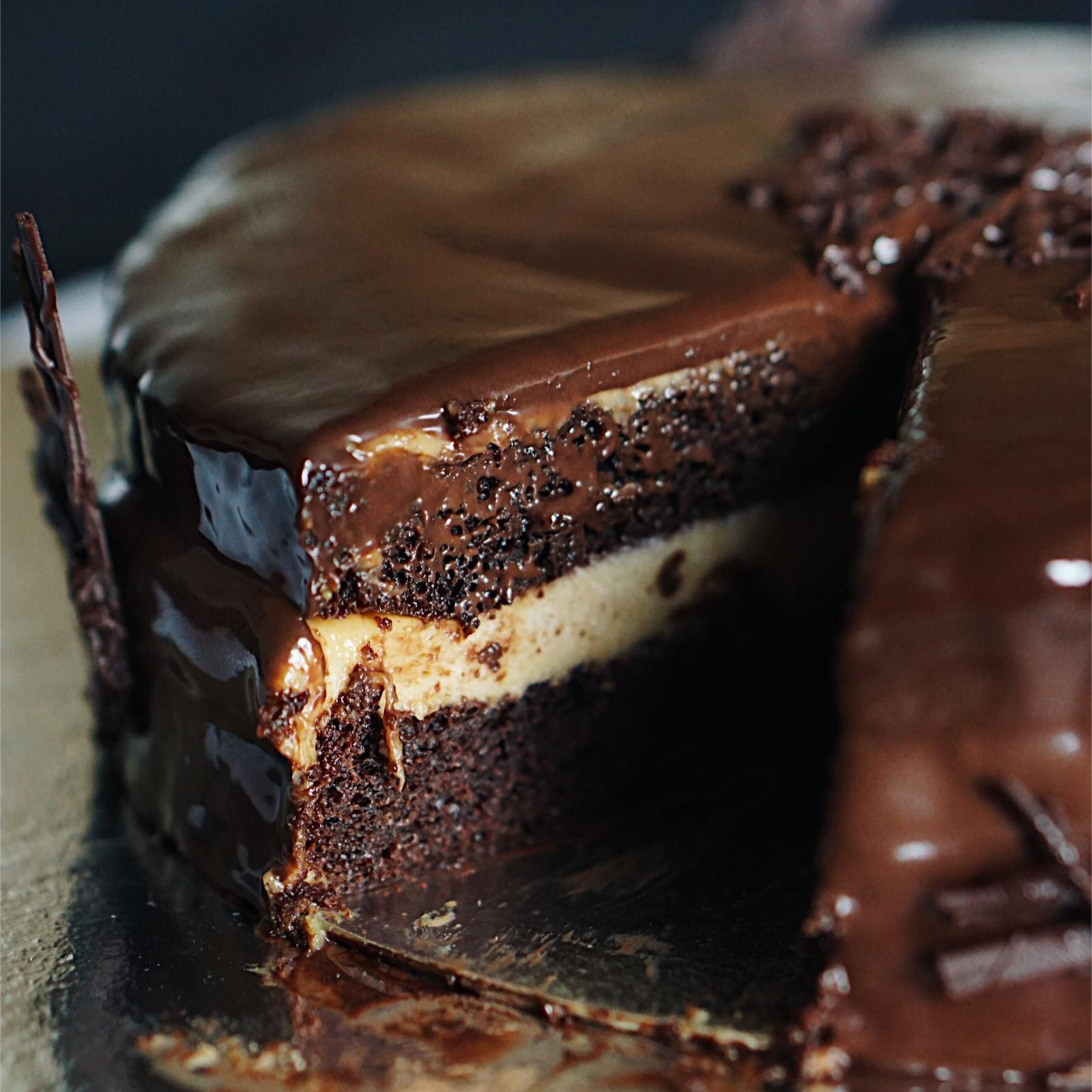Introduction
Lobster tails are widely regarded as one of the most luxurious and sought-after seafood delicacies. Learn more about lobster tails and why they’re a favorite choice for fine dining and special occasions. With their tender, flavorful meat and elegant presentation, they have become synonymous with gourmet meals and celebrations.
What makes Lobster meat particularly popular is their versatility in the kitchen. They can be grilled, baked, boiled, or even broiled, each method bringing out unique flavors and textures. This adaptability makes them a favorite among home cooks and professional chefs alike. Additionally, their rich taste pairs beautifully with a variety of sides, sauces, and seasonings, allowing endless culinary creativity.
The purpose of this post is to provide a comprehensive guide to lobster tails, from selecting the freshest ones to mastering different cooking techniques. Whether you’re a seafood aficionado or a curious beginner, this guide will help you elevate your cooking skills and create unforgettable meals featuring this exquisite ingredient. Dive in to discover everything you need to know about enjoying Lobster meat at their finest.

What Makes Lobster Tail a Gourmet Delight?
Lobster meat have long been celebrated as a symbol of luxury and indulgence, earning their place on menus in some of the world’s most prestigious restaurants. But what makes them truly special? Their appeal goes beyond the elegant presentation, offering a unique combination of flavor, texture, and nutritional benefits that make them stand out in the culinary world.
Why Lobster Tail Is Considered a Luxury Food
Its Rich Flavor and Tender Texture
The meat of a lobster tail is prized for its sweet, delicate flavor and tender yet firm texture. Unlike other seafood, lobster meat has a natural richness that doesn’t require heavy seasoning or preparation to shine. This makes it a favorite for those seeking a refined, uncomplicated dining experience. Its distinctive flavor profile is both subtle and luxurious, leaving a lasting impression with every bite.
Association with Fine Dining and Special Occasions
Lobster meat have become synonymous with celebration and sophistication. Whether served at weddings, anniversaries, or high-end restaurants, they carry an air of exclusivity and indulgence. Historically, lobster was considered a delicacy only accessible to the wealthy, and although it has become more widely available today, it still retains its status as a luxury food. The presentation of a perfectly cooked lobster tail—often accompanied by melted butter and elegant garnishes—further cements its place as a centerpiece of fine dining.
Health Benefits of Lobster Tail
High Protein and Low Fat
Lobster meat are not just delicious but also highly nutritious. They are an excellent source of lean protein, making them a great choice for those looking to build or maintain muscle mass. With very low fat content, they are a heart-healthy option for seafood lovers. A single lobster tail can provide a significant portion of your daily protein needs without contributing to excess calories.
Rich in Omega-3 Fatty Acids and Essential Nutrients
Lobster meat are packed with omega-3 fatty acids, which are known to support heart health, improve brain function, and reduce inflammation in the body. They are also a rich source of essential vitamins and minerals, including vitamin B12, zinc, selenium, and phosphorus. These nutrients contribute to energy production, immune system function, and overall well-being. Including lobster tail in your diet can be both a treat for your taste buds and a boost for your health.
How to Choose the Best Lobster Tail
Selecting the right lobster tail is a critical step in ensuring a delicious and satisfying meal. Whether you’re preparing a casual dinner or hosting a formal event, the quality of the lobster tail can make or break the dish. Here’s a detailed guide to help you make the best choice, covering key considerations like freshness, type, and where to shop.
Fresh vs. Frozen Lobster Tail
How to Identify Fresh Lobster Tail
Fresh Lobster meat are often considered the gold standard for flavor and texture. When selecting fresh tails, look for the following indicators:
- Appearance: The shell should be firm, with a vibrant color and no discoloration. Avoid shells with a grayish hue, as this may indicate that the lobster was not fresh when harvested.
- Smell: Fresh Lobster meat should have a mild, ocean-like scent. A strong, fishy odor is a sign that the lobster is no longer fresh.
- Texture: The meat inside the shell should be firm and slightly translucent, not mushy or opaque.
Pros and Cons of Frozen Lobster Tail
Frozen Lobster meat are a convenient option, especially if fresh tails are unavailable in your area. They are flash-frozen shortly after being caught, which helps preserve their quality. However, there are some trade-offs to consider:
- Pros:
- Widely available year-round.
- Often more affordable than fresh tails.
- Freezing locks in flavor and nutrients when done correctly.
- Cons:
- May lose some texture or flavor during freezing.
- Risk of freezer burn if not stored properly.
- Requires thawing, which adds preparation time.
Tip: If opting for frozen Lobster meat, look for packaging that indicates they were “wild-caught” and “flash-frozen” for the best quality.
Types of Lobster Tail: Warm-Water vs. Cold-Water
Differences in Taste and Texture
- Warm-Water Lobster meat:
- Origin: Typically sourced from regions like the Caribbean and South America.
- Taste: Often milder but slightly less sweet compared to cold-water varieties.
- Texture: Can be less firm and more prone to becoming mushy if overcooked.
- Cold-Water Lobster meat:
- Origin: Harvested from colder regions like Maine, Canada, and New Zealand.
- Taste: Renowned for their sweet, rich flavor.
- Texture: Firm and tender, making them the preferred choice for many seafood enthusiasts.
Recommendations for Different Recipes
- Cold-Water Lobster meat: Ideal for dishes where the lobster flavor is the star, such as broiled or grilled tails with butter.
- Warm-Water Lobster meat: Suitable for recipes with bold seasonings or sauces, such as curries or pasta dishes, where the lobster complements other flavors.
Where to Buy High-Quality Lobster Tail
Local Seafood Markets
Shopping at local seafood markets is a great way to ensure freshness and quality. These markets often source their seafood directly from nearby waters, giving you access to the freshest catch. When buying from a market:
- Ask the seller about the origin of the Lobster meat.
- Inquire whether the tails were previously frozen or are truly fresh.
- Look for certification labels that indicate sustainable fishing practices.
Online Retailers
Online seafood retailers offer convenience and a wide selection of Lobster meat, including hard-to-find varieties. Many companies specialize in shipping fresh or flash-frozen seafood directly to your doorstep. When buying online:
- Choose reputable retailers with strong customer reviews and satisfaction guarantees.
- Look for clear information about the lobster’s origin, such as whether it’s wild-caught or farm-raised.
- Ensure proper packaging, such as vacuum-sealing and overnight shipping, to maintain freshness.
Tip: Compare prices and shipping options from both local markets and online retailers to find the best balance of quality and value.

Best Ways to Cook Lobster Tail
Cooking lobster tail is a rewarding experience that brings out its naturally sweet and tender qualities. Whether you’re grilling, baking, or boiling, each method offers unique advantages, textures, and flavors. Here’s an in-depth guide to the best ways to prepare lobster tail, complete with tips to ensure perfection.
Grilling Lobster Tail
Step-by-Step Guide to Grilling
- Prepare the Lobster Tail:
- Start by thawing the lobster tail if it’s frozen.
- Using kitchen scissors, cut through the top of the shell lengthwise to expose the meat. Gently loosen the meat from the shell but leave it attached at the base for an elegant presentation.
- Preheat the Grill:
- Set your grill to medium heat (about 375°F/190°C).
- Season the Lobster Meat:
- Brush the meat with olive oil or melted butter. Sprinkle with salt, pepper, and your choice of spices.
- Grill the Lobster Tail:
- Place the lobster tail meat-side down on the grill for about 4-5 minutes.
- Flip the tail and grill shell-side down for another 3-4 minutes, brushing with butter or marinade as it cooks.
- Check for Doneness:
- The meat should turn opaque and white, with an internal temperature of 140°F (60°C).
Tips for Adding Flavor (Marinades and Seasonings)
- Use garlic butter, lemon juice, and paprika for a classic flavor.
- Experiment with marinades such as teriyaki, chili-lime, or herb-infused oils.
- Add a sprinkle of fresh herbs like parsley or chives for garnish after grilling.
Baking Lobster Tail
Baking Times and Temperatures for Perfection
- Preheat your oven to 425°F (220°C).
- Prepare the lobster tail by cutting the shell lengthwise and exposing the meat.
- Place the Lobster meat on a baking sheet or in a shallow baking dish.
- Brush the meat generously with melted butter and season with salt, pepper, and garlic powder.
- Bake for 8-12 minutes, depending on the size of the tail, until the meat is opaque and reaches an internal temperature of 140°F (60°C).
Tip: Basting the tails with butter halfway through baking enhances flavor and prevents dryness.
Popular Baked Lobster Tail Recipes
- Garlic Butter Lobster Tail: A classic recipe featuring a rich garlic butter sauce.
- Stuffed Lobster Tail: Fill the tail with a breadcrumb and herb mixture before baking for a gourmet twist.
- Parmesan Crusted Lobster Tail: Top with grated Parmesan cheese for a crispy, cheesy crust.
Boiling Lobster Tail
How to Boil Lobster Tail Without Overcooking
- Fill a large pot with enough water to cover the Lobster meat. Add a pinch of salt for seasoning.
- Bring the water to a rolling boil.
- Gently place the Lobster meat into the boiling water.
- Boil for 1 minute per ounce of tail weight (e.g., a 6-ounce tail requires 6 minutes).
- Remove the tails with tongs and immediately place them in an ice bath to stop the cooking process.
Tip: Use a meat thermometer to ensure the meat reaches 140°F (60°C) for perfect doneness.
When Boiling Is the Best Option
- Boiling is ideal for recipes that require further cooking, such as lobster tail pasta or soups.
- It’s also a quick and straightforward method for those new to preparing lobster tail.
Lobster Tail Pairings for an Unforgettable Meal
Pairing lobster tail with the right side dishes, wines, and desserts can elevate your dining experience from delicious to extraordinary. The richness of lobster tail is complemented by flavors and textures that balance its natural sweetness, creating a harmonious and indulgent meal. Here’s how to craft the perfect menu to accompany your lobster tail.
Side Dishes That Complement Lobster Tail
Lobster tail’s rich and tender meat pairs beautifully with a variety of side dishes, from light and refreshing vegetables to creamy, indulgent starches. Here are some popular options to consider:
Vegetable-Based Sides
- Garlic Butter Asparagus: The earthy flavor of asparagus, lightly sautéed in garlic butter, adds a fresh, crisp contrast to lobster’s richness.
- Roasted Brussels Sprouts: Roasted with olive oil and a sprinkle of sea salt, Brussels sprouts provide a savory depth to the meal.
- Lemon Zest Green Beans: The citrusy brightness of lemon zest complements the sweet flavor of lobster tail.
Starch-Based Sides
- Creamy Mashed Potatoes: A classic pairing, mashed potatoes offer a velvety texture that contrasts beautifully with the firm lobster meat.
- Risotto: Try a light lemon or Parmesan risotto for a luxurious side that mirrors the elegance of lobster tail.
- Buttery Dinner Rolls: Perfect for soaking up any leftover garlic butter or sauce from the lobster.
Salads
- Caesar Salad: The tangy dressing and crunch of croutons provide a satisfying balance to lobster’s softness.
- Citrus Avocado Salad: A vibrant mix of citrus fruits, creamy avocado, and a light vinaigrette can refresh your palate between bites.
Wines to Pair with Lobster Tail
The right wine can enhance the flavor of lobster tail, highlighting its sweetness and balancing its richness. Here are some excellent wine pairings:
White Wines
- Chardonnay: A buttery, oaky Chardonnay complements the richness of lobster tail, especially when served with butter-based sauces.
- Sauvignon Blanc: For a lighter pairing, Sauvignon Blanc offers crisp acidity and citrus notes that brighten the meal.
- Riesling: A slightly sweet Riesling can balance savory and spicy lobster preparations, adding a touch of elegance.
Rosé Wines
- Dry Rosé: The light fruitiness of a dry rosé pairs well with lobster’s sweet and tender meat, particularly when grilled or baked.
Sparkling Wines
- Champagne or Prosecco: The effervescence of sparkling wines cuts through the richness of lobster tail and adds a celebratory touch to the meal.
Tip: When pairing wines, consider the preparation method of the lobster tail. For instance, heavily seasoned or spicy dishes may pair better with sweeter or more robust wines.
Desserts to Complete the Meal
After indulging in a rich lobster tail dish, a light and refreshing dessert is the perfect way to cleanse your palate and end the meal on a high note. Here are some delightful dessert ideas:
Fruit-Based Desserts
- Citrus Sorbet: A tangy sorbet made from lemon, lime, or orange offers a refreshing finish.
- Berry Parfait: Layers of fresh berries, whipped cream, and granola create a dessert that is both light and satisfying.
Light Pastries
- Lemon Tart: The tartness of lemon paired with a buttery crust complements the richness of lobster tail.
- Almond Biscotti: These crisp cookies are a simple yet elegant choice, especially when paired with coffee or tea.
Other Options
- Vanilla Panna Cotta: This creamy dessert is light yet indulgent, providing a perfect balance to the meal.
- Dark Chocolate Mousse: For those who enjoy a richer dessert, the bitterness of dark chocolate contrasts beautifully with the sweetness of lobster.
Lobster Tail 101: Everything You Need to Know

This blog post is your ultimate guide to enjoying lobster tails, a luxurious seafood delicacy loved for its tender meat and sweet flavor. It covers everything from selecting the best lobster tails—whether fresh, frozen, warm-water, or cold-water varieties—to mastering cooking techniques like grilling, baking, and boiling. You'll also find pairing ideas for side dishes, wines, and desserts to create a truly unforgettable meal.
In addition, the post answers common questions about portion sizes, proper storage, and sustainable sourcing, ensuring you make informed and eco-conscious choices. Whether you're a seasoned chef or a seafood beginner, this guide has everything you need to elevate your lobster tail dining experience. Dive in, try the recipes, and make your next meal a memorable one!
Common Questions About Lobster Tail
For many, lobster tail is a special treat, and questions about serving sizes, storage, and sustainability are common when planning a meal. Answering these questions ensures that you can confidently enjoy lobster tail while minimizing waste and making informed, eco-friendly choices. Here’s a detailed exploration of these common concerns.
How Much Lobster Tail Should You Serve Per Person?
General Serving Sizes Based on the Occasion
- For a Main Course: If lobster tail is the star of the meal, aim for 6-8 ounces per person. This typically equates to one large tail or two smaller tails per serving.
- For Appetizers or Side Dishes: When served as part of a larger spread, plan for 3-4 ounces per person. This is ideal for salads, pasta dishes, or surf-and-turf meals.
- For a Buffet or Large Gathering: Offer slightly smaller portions, around 4-6 ounces per person, to ensure everyone gets a taste while allowing room for other dishes.
Tip: Consider the appetite of your guests and the number of courses you’ll be serving. Larger appetites or a lobster-focused menu may require more generous portions.
How to Store Leftover Lobster Tail
Best Practices for Refrigeration
- Cooling Down: Let the lobster tail cool to room temperature before storing. Avoid leaving it out for more than two hours to prevent bacterial growth.
- Storage Containers: Place the lobster tail in an airtight container or wrap it tightly in plastic wrap and aluminum foil to lock in freshness.
- Refrigeration: Store in the refrigerator at 32°F–40°F (0°C–4°C) and consume within 2-3 days.
Best Practices for Freezing
- Preparation for Freezing: If you plan to freeze leftovers, wrap the lobster tail in plastic wrap, then place it in a freezer-safe bag or container. Remove as much air as possible to prevent freezer burn.
- Freezing Duration: Lobster tail can be safely frozen for up to 3 months without significant loss of flavor or texture.
Reheating Leftover Lobster Tail
- Gentle Methods: Reheat lobster tail in a steamer or in the oven at low heat (about 275°F/135°C) to prevent it from drying out. Add a little butter or water to keep it moist.
- Avoid Microwaving: The high heat of a microwave can make lobster meat rubbery and less enjoyable.
Tip: Use leftovers in recipes like lobster rolls, salads, or pasta dishes for a fresh twist on day-two lobster.
Is Lobster Tail Sustainable?
Overview of Sustainable Seafood Practices
With growing awareness of environmental concerns, choosing sustainably sourced lobster tail is an important consideration. Here’s what to look for:
- Wild-Caught Lobster: Lobsters harvested from the wild often use methods that protect marine ecosystems. Look for certifications from organizations like the Marine Stewardship Council (MSC) to ensure the lobster is sustainably caught.
- Farmed Lobster: Though less common, farmed lobster can be sustainable when raised in eco-friendly aquaculture systems that minimize environmental impact.
- Seasonal Fishing: Buying lobster tail during its peak season reduces the strain on lobster populations and ensures better quality.
How to Identify Sustainable Lobster Tail
- Look for eco-certification labels, such as MSC or Best Aquaculture Practices (BAP), on packaging.
- Research the origin of the lobster tail. Lobsters from regions with strict fishing regulations, like Maine or Canada, are often more sustainable.
- Avoid purchasing tails from regions known for overfishing or harmful practices, such as some parts of the Caribbean.
Why Sustainability Matters
- Protecting marine ecosystems ensures that lobster populations remain abundant for future generations.
- Sustainable fishing practices often yield higher-quality seafood, as they prioritize ethical harvesting methods.
- Supporting sustainable suppliers encourages more responsible practices within the seafood industry.
Conclusion
Lobster tails are a culinary treasure, combining indulgent flavors with incredible versatility in the kitchen. Whether you’re preparing them for a romantic dinner, a festive gathering, or simply as a personal treat, Lobster meat deliver a dining experience that is as satisfying as it is memorable. From their tender, sweet meat to their elegant presentation, they continue to be a favorite choice for seafood lovers around the world.
This guide has explored everything you need to know about Lobster meat—from selecting the freshest options to mastering various cooking methods like grilling, baking, and boiling. We’ve also highlighted the perfect pairings and addressed common questions to help you make informed decisions. No matter your skill level in the kitchen, there’s a lobster tail recipe or method that’s right for you.
We encourage you to step into your kitchen and try one of the cooking methods for lobster tail shared in this post. Whether you opt for the smoky flavors of grilling, the rich indulgence of baking, or the simplicity of boiling, you’re sure to create a meal that leaves a lasting impression. Don’t forget to explore perfect lobster tail pairings to elevate your dining experience. Finally, share your favorite lobster tail recipes in the comments below to inspire others and celebrate the versatility of this seafood delight!
Finally, we’d love to hear from you! What’s your favorite way to prepare and enjoy Lobster meat? Do you have a secret recipe or a pairing idea that never fails to impress? Share your tips, stories, and recipes in the comments below to inspire fellow seafood enthusiasts. Let’s celebrate the delicious versatility of lobster tails together!





